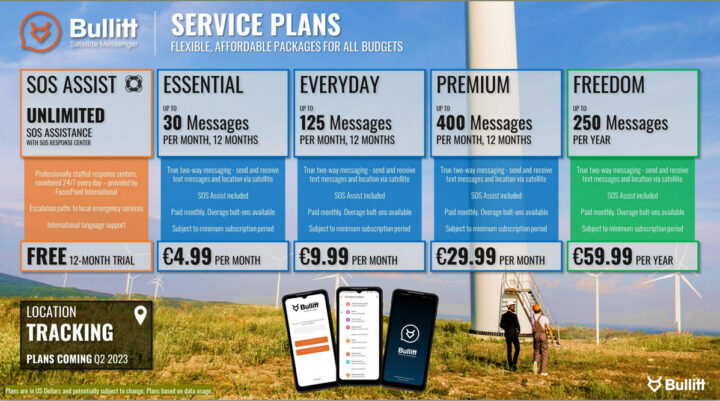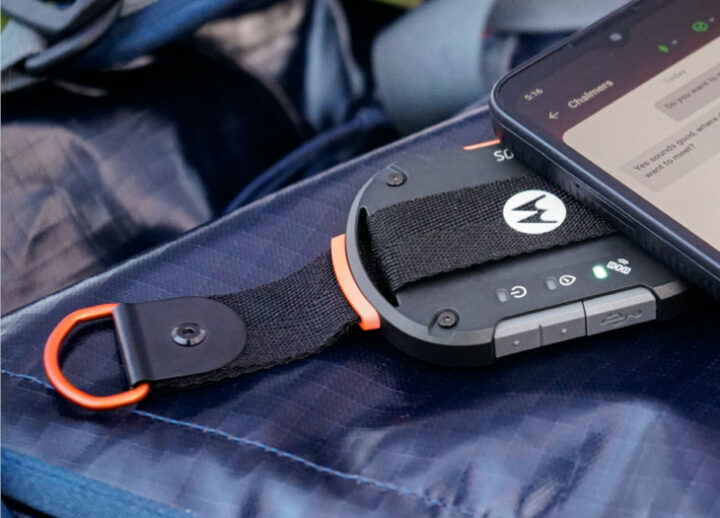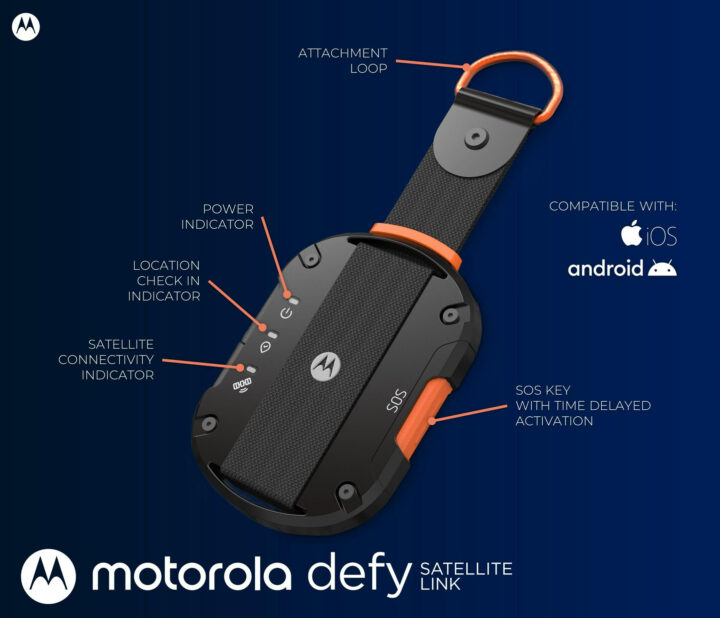Motorola Defy Satellite Link is a Bluetooth device that can affordably bring 2-way satellite communication to any smartphone thanks to the latest 3GPP NTN (Non-Terrestrial Network) technology implemented in the MediaTek MT6825 connecting to the Bullitt Satellite Connect platform.
Satellite phones and hotspot has been around for years through products such as the Iridium Go! Satellite Wi-Fi hotspot that goes for over $1,000 without a data plan, pricing that does not make it conducive to mass adoption. But silicon vendors and phone manufacturers have started to add more affordable 2-way satellite connectivity to smartphones, for example with the Snapdragon Satellite initiative, currently using Iridium, but with plans to switch to 5G NTN in due time.
Motorola Defy Satellite Link key features and specifications:
- SoC – MediaTek M6825 chip compliant with 3GPP R17 NTN standard (bands: 23/255/256), support for Geosynchronous Equatorial Orbit (GEO) constellations
- GNSS – GPS, Glonass, Galileo, Beidou
- Host connectivity – Bluetooth 5.1 for Android and iOS smartphones
- Bullitt Satellite Messenger app for two-way messaging over satellite, as well as location sharing and SOS assistance (phone not required for the latter two)
- Audio – Buzzer
- USB – 1x USB port for charging
- Misc – Power key, Physical SOS key, location ‘Check In’ button, lanyard to attach to clothes
- Battery – 600 mAh capacity battery good for several days on a charge
- Dimensions – 70 x 50 11mm
- Weight – 70 grams
- Certifications – Mil-Spec 810H testing, IP68 rating (dust-and-waterproof)
- Temperature Range/Shock – -30°C to 55°C for up to 24 hours
While the Motorola Defy Satellite Link is designed for 2-way satellite communication in remote areas where cellular and Wi-Fi signals are not available like the Iridium solutions, it does not seem to support audio, and can only be used to receive and send messages. The Defy users can receive a simple SMS to their existing phone with the Bullitt Satellite Messenger app, which only needs to be installed on Android or iOS to respond.
The Motorola Defy satellite link, and other 5G NTN solutions, will be much cheaper than Iridium phones or hotspots, with the Defy satellite link becoming available in April 2023 starting at $99 / €119 / £99 for the device only, and a $149 / €169/ £149 bundle that adds a one-year subscription to the Essentials Messaging service plan for up to 30 two-way messages per month and SOS Assist. If you prefer to purchase a complete satellite phone, the Motorola Defy 2 smartphone will be available in about the same timeframe.

The Motorola Defy Satellite Link will be showcased at the Mobile World Congress (MWC23) on Sunday, February 26, and MediaTek will be exhibiting MT6825 solutions from Motorola and the CAT S75 phone during the event between February 27 and March 2, 2023. Bullitt plans for Europe and North America to be covered this quarter, Oceania, Africa, and Latin America around mid-2023, and other regions by the end of the year.
Via Liliputing

Jean-Luc started CNX Software in 2010 as a part-time endeavor, before quitting his job as a software engineering manager, and starting to write daily news, and reviews full time later in 2011.
Support CNX Software! Donate via cryptocurrencies, become a Patron on Patreon, or purchase goods on Amazon or Aliexpress







Over priced still. We talk around the world by internet and satellite already, Just no signal spots are the issue. Which are huge areas.
Satellite mini swarms are gong to cause to much clutter in my opinion.
Great idea. Every back country hiker, camper, hunter, and off roader will buy one. There’ll be no reason for someone to die of thirst, exposure, injury or medical emergency because they are lost, and/or out of cell phone coverage just a few miles from civilization.
Exactly! Really cool seeing the price come down on these. For the outdoorsy types this is really a nice tool.
That’s why you carry red flares. A small helium balloon, hung repeat location transmitter.
Also a wind up phone charger/light.
There has been a location watch ( expensive ) for years. Richard Hammond tested it.
All modern miniature tech. Lightweight and cheap.
I have a AA gadget, that with one AA battery repeatedly charges a phone for one text ( cost £1, years back and still works ) old 2g phone for now rings 999 in UK. A wind up torch. Red flares and location GPS, pencil and paper.
Failing to plan is planning to fail ( Old wise words )
I once walked Yorkshire’s three peaks in 9hrs 24 mins. Now days knees ache 😅🤐👍
Or instead of schlepping all that crap and praying you just this lightweight cheap device.
Still you need a charged smartphone to use it and a paid subscription. A flare/balloon/torch is much cheaper and it’s a one-time purchase.
No you don’t even need a phone to send an SOS with your location the device has its own battery.. $99 to save your life is the bargain of a lifetime. BTW a balloon could be blown miles away from your location in minutes. Balloon flare is dumb idea If I’m going to be away from power for a long time I’m carrying a small, light weight, solar charging system.
Given that this is not an outdoor focused crowd here, as demonstrated by the other comments a few clarifications.
This is not a new thing, PLBś started being a thing in the 90’s and Sat messagers in mid 2000.
What it is is a lot cheaper. by comparison and inreach mini is about 300 USD with 30 USD per month subscription.
I know it’s not a new thing but it’s a very cost effective version of a Garmin, Spot,etc